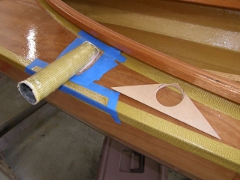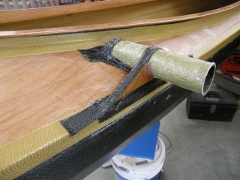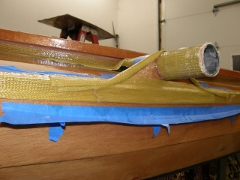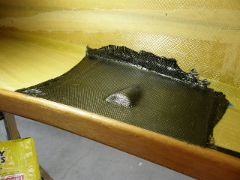Lateral Resistance for the Cruising Sailing Canoe:
from Rob Roy's keel strip to Bufflehead's leeboard, for an "all-round" canoe
Preface: While it's flattering to have conclusions verified, I'm reminded how we stand on the shoulders of others. In trying to answer editors Wick and Asplundh about Bufflehead's leeboard mount, I scrutinized more of the classic literature - thanks to the superb online work of Tim Gittins, Dan Miller and Craig O'Donnell. Some of it I'd only perused in the last 25 years. I re-read much, too, from hard-copy books that had moved me over that time, finding valuable words about more than weatherliness.
Although early icons of sailing canoes acknowledge the Scot, John MacGregor, as the "father of the modern canoe," and historians might say, "the decked sailing canoe," his Rob Roy canoes barely sailed to weather.
But he loved sailing. His series of seven Rob Roys had lugs and jibs, along with inch-deep keel strips. He had eight suits of sails made to get one set to fit well for his second long trip, The Rob Roy on the Baltic (1867). For his third long trip, The Rob Roy on the Jordan (1869), in his fifth Rob Roy, he dyed a lugsail and jib blue for less glare and visibility. Apparently, though, he thought he wouldn't be able to have a boat which could sail well to weather on trips, and be lean and agile enough to paddle as he wanted. He wrote, "Sailing is a mistake, unless with a favourable wind." Although after his second trip, he wrote, "Experiments as to the use of leeboards for improving the sailing qualities of a canoe have convinced me that a light leeboard of sheet-iron or deal will be a useful addition to the gear." But he had only his inch-deep keel for the Jordan trip.
MacGregor's fellow Royal Canoe Club member, Warington Baden-Powell, did want to sail upwind. He built a series of canoes each named Nautilus, beginning in the late 1860s. (He used no numbers; enthusiasts added them later.) The first was a Rob Roy #2 model, 14' x 26." Then came Nautilus #2, and #3, both 14' x 28". Nautilus #3 was his Baltic ride in 1869. His Nautili continued, none alike, gaining beam, and center or lee boards, to the #8 of 1881 with 33" beam and an 83 pound centerboard. Nautilus #9, it appears, was a 16"-deep, chunky canoe-yawl.
"Leeboards," Baden-Powell said in his 1871 book, Canoe Travelling, Log of a Cruise on the Baltic and Practical Hints on Building and Fitting Canoes. "For ordinary pleasure cruising, the trouble of using a leeboard is hardly repaid by the very small amount of 'weather gauge' gained on short tacks; but on a long voyage where time and strength must be economized, many a side slant of wind may be successfully sailed to by the help of a well-proportioned and fitted leeboard."
Baden-Powell wrote, "In canoe traveling there are two distinct pleasures: one, the healthful enjoyment of a free and easy life in fine weather and varied scenery: and the other, the more sensational, cracking on under sail, and working her successfully through and over heavy seas; not in the foolhardy sense 'courting danger'...(rather) to enjoy for a short time the excitement of flitting on the brink of eternity."
Compared to MacGregor, Baden-Powell seemed more of a sailor than paddler. "As to paddling against a head wind in open water in any but a long, low, narrow paddling canoe, it is simply selfinflicted hard labour; sails would do the work in far less time, and with ease and comfort to the canoeist."
MacGregor preferred traveling alone, but Baden-Powell did not. MacGregor wrote in The Rob Roy on the Jordan, "Long consideration, and a resolve to leave nothing haphazard, are the true secrets of ensuring success, and here comes in one of the great advantages of traveling alone - you have time and silence to consider maturely. You do not mar your plans by feeble compromises. You see, hear, and think a great deal more than if a 'pleasant companion' is beside you all day, whose small talk (and your own) must run dry in a month, and neither of you is free. In these solitary expeditions I have never a sensation of loneliness ... one's plans are quietly perfected."
Whereas Baden-Powell wrote, "Many imagine that canoe traveling must necessarily be a solitary performance: on the contrary, I think the more the merrier and the safer, provided that each man is 'skipper of his own boat.' ...But on a long trip I should prefer as many companions as possible, for, even when two are together, every trouble is halved and pleasure doubled. ...I will never get the Nautilus 'under weigh' for a long cruise, under a self-imposed sentence of solitary confinement."
|
|
Bill Ling reaches for the bow of Jim Renouf's Bufflehead design canoe, Eden, during a July 2009 daysail on Lower Saranac Lake, NY. Photo by Hugh Horton. |
|---|
New Yorker C. Bowyer Vaux, in his 1888 book, Canoe Handling, The Canoe: History, Uses, Limitations and Varieties, Practical Management and Care and Relative Facts, developed five classifications of canoes, all of which can be singlehanded. Class I is paddling only; Class II includes sailing off the wind, like MacGregor; Class III is the versatile paddler-sailer, including to weather; Class IV: "They have fixed deep keels or heavy centerboards of iron ... (and) are heavy and tiresome to paddle." Class V includes ballasted "canoe-yawls," drawing over a foot with boards up, and four or more feet of beam.
Of Class III, Vaux says "The sail and paddle are used about equally. (The '50/50 boat.') The length and breadth of these canoes are means between the extreme length and beam for one use only. These canoes, by (utilizing) keels or centerboards, are enabled, under sail, to make to windward. One man can lift and carry a Class III canoe when relieved of its load of ballast or cargo."
|
|
Hugh Horton test pilots Bufflehead after its initial launch, August 2007. Photo by Bill Ling. |
|---|
W.P. Stephens was a New York boatbuilder, a founding member of the American Canoeing Association, and longtime yachting-canoeing editor of Past and Future of American Canoeing 1880-1900, addressed the National Canoe Congress. He defined "...the canoe proper... fitted for one man and capable of being sailed, paddled or handled on shore by him alone...," which seems to parallel Vaux's Class II and III.
Stephens wrote, "The majority of American canoes in 1880 were variations of the Nautilus type, 14' by 30" in dimensions, with moderate sheer and mainly fitted with shallow keels. In model, build and fittings they were allround cruising craft, and most of them had made cruising records before doing much racing. Every canoe that came to camp (following Nathaniel Bishop's call to assemble at Lake George in 1880) carried her owner's tent, bed and camp outfit, and raced with her cruising rig.
"From 1880 to 1886 the improvement of the canoe and her fitting was carried on rapidly at the hands of such men as Vaux, Gibson, Oliver, Bailey, Richards and other old-time cruisers and racers. The main end of all was to produce a perfect all-round canoe, in which, if time permitted, one might cruise to a meet and yet win both sailing and paddling prizes."
 |
Reflections of Bufflehead at rest; onshore at Lower Saranac Lake, NY, September 2009. Photo by Hugh Horton. |
|---|
Considering the years from 1890 to 1900 he said, "...the perfection of the sailing (racing) machine has driven out entirely the old all-round cruising and racing canoe."
Vaux agreed in his 1894, Canoes and Canoeing, "The modern sailing canoe is the direct result of racing. The canoes that entered the races at the annual American Canoe Association meets, previous to 1888, were all fairly good cruising canoes. Since then, the purely racing machine has come to the front, and the general utility canoe relegated to the rear."
But Stephens saw that people in 1900, as they do now, "...prized the freedom and independence of canoeing and yet wished for something abler, drier and more comfortable than the 30" canoe. ...Though the maximum limit of beam for a 'canoe' in this country is still 30", as it has always been, many good craft have been built and used with a breadth of from three to four feet."
Stephens asked, "Is it possible to... design a larger, wider and abler craft that will become generally popular as the old 30" canoe was in 1880?"
He wasn't thinking leeboards, though. From his 1889 Canoe and Boat Building, A complete manual for amateurs, "...the lee board being too clumsy a device to be of use in a canoe, though at one time occasionally used ...will not answer for a decked one."
But, in about 1917, Ralph Rogers modified his Rushton Vesper with an exquisite leeboard and mount. It's in The Adirondack Museum in Blue Mountain Lake, New York. I saw it in the early '90s and it blew me away then and still does. The blade's section is lens shaped, symmetrical fore and aft, but Curator Hallie Bond told me, it's flatter on the inside. This is the first shaped leeboard of which I'm aware.
|
|
The ancestor of Bufflehead's leeboard: Rushton Vesper, modified by Ralph Rogers, 1917. |
|---|
O.S. Tyson's 1935, Sailing Canoes, A Brief History, has an ACA Open Sailing Canoe with a drawing of streamlined leeboard sections, reminiscent of an NACA (National Advisory Committee for Aeronautics) section.
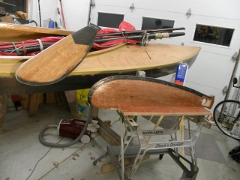 |
Sailing canoe leeboards under construction, showing NACA foil shapes and carbon fiber reinforcement at the pivot point and on the trailing edges. Photo by Hugh Horton. |
|---|
Bufflehead's single leeboard mount is of plywood, carbon, kevlar and epoxy. The board pivots up and down on the port side, its axle revolving in a horizontal tube perpendicular to the boat's centerline, which does not cross the cockpit. Jan Gougeon's system is the best I've seen - friction is applied by squeezing the slotted tube around the axle. He's thought through an evolution of it, too, using a tapered axle in a cone, rather than a cylindrical axle in a tube. Either way, friction is easily set as it's wanted for fingertip control, and it seldom needs readjustment.
| The Leeboard Mounting Tube: a key element of modern-day lateral resistance |
|---|
Bufflehead's leeboard is an NACA foil section, about 0008. The board is of meranti, moderately low density, heavily reinforced with layers of carbon cloth on both sides at the axle. The lower leading edge, which is abused by rocks and oysters, has a thick, glass inlay. The trailing edge is strengthened with carbon fiber.
The Bufflehead design's sailing performance would put it into and beyond Vaux's Class IV, while the weight (cartop 45-60 pounds; 70-85 pounds overall dry weight) and size (15.5' x 33") allow the design to remain in Class III, but take it out of Class II.
Vaux wrote in 1888, "Eight points make up a right angle. A canoe under the most favorable conditions cannot sail within less than four points of the wind. In close hauled sailing, the angle the canoe makes with the course of the wind is between 50 and 60 degrees, or about five points."
Unless we're in open, rough water, it's common for a Bufflehead or Serendipity sister to tack just inside 90 degrees. Their windward ability is from the combination of slick hulls, clean sail rigs, suitable rudders, and appropriate leeboards.
Our devices for lateral resistance have changed in the last 140 years, but our goal of an "all-round" boat hasn't. I think if ghosts of MacGregor, Baden- Powell, Vaux, and Stephens found our canoes while strolling a fogged-in beach, they'd smile.
In addition to thanking those mentioned in the article - Gittins, Miller, O'Donnell, and Bond - I want to thank Charlie Campbell, Tony Ford, Ben Fuller, Harri Luukkanen, John Summers, and Marilyn Vogel. All have been helpful in conversation or correspondence. -HH


